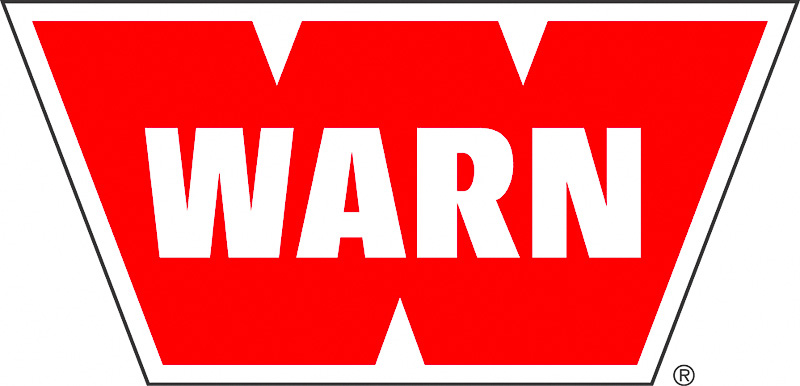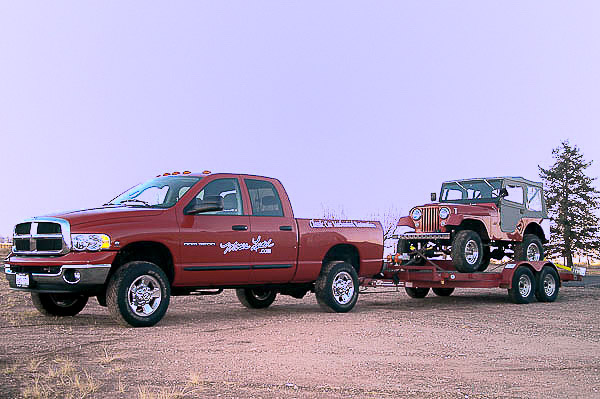
When you need to safely move a Jeep 4WD, there is no better method than a car hauling trailer. Whether enclosed or a flat deck design (like above), a properly rated trailer, equipped with tandem axles and brakes at each wheel, provides the most sensible, safe platform.
Pulling a car hauling trailer is much safer than “flat-towing” your Jeep with a tow bar. The properly equipped trailer has electric or hydraulic brakes, two axles, commercial tires of high load rating and a load distribution or “equalizing” hitch. A sway control brake is a useful option.
Trailering, once you master steering and braking, is considerably safer than flat towing a vehicle. You have the advantage of trailer brakes that work in tandem with the tow vehicle’s brakes. The trailer yoke provides a means for backing up the trailer safely, in a controlled manner. Quality tie-downs stabilize weight on the trailer, allowing the tow vehicle to corner and handle better.
In the illustrations below, I share tips on loading, tying down and trailering a Jeep safely. These methods have served me well. For the last twenty years, using a haul trailer has enabled safer, more comfortable trips over long distances. The trailered Jeep arrives ‘ready to go’! For 4WD Mechanix Magazine chores, towing with a Cummins-powered Dodge Ram 3500 4WD Quad-Cab (140.5″ wheelbase) makes long distances a snap. We get there in comfort and safety!
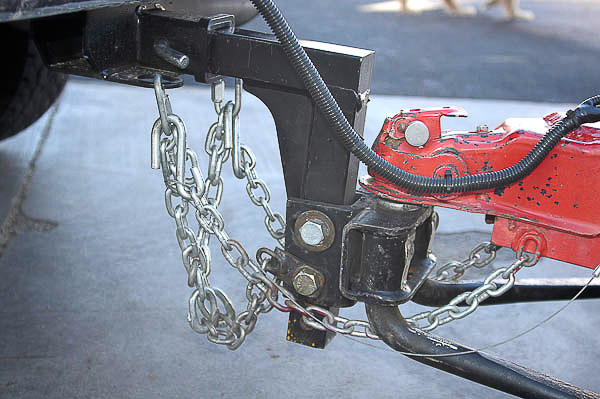
Safety begins with the hitch. I use a hefty, adjustable drop hitch that slides into the OEM Type III (2-inch square) receiver. The trailer ball is 2-5/16″ diameter. Two torsion bars at bottom are part of the equalizing or load distribution hitch arrangement. Torsion bars swing laterally in hitch sockets. Protect safety chains and electrical wiring.

Load of torsion bars on equalizing hitch is adjustable via chains and clamp-on brackets at the yoke rails. Tension on the bars determines ride height of the tow vehicle. Despite the trailer load, you can level the tow vehicle. The added benefit is that the trailer and tow vehicle’s chassis rise and set together. This smooths out the road and enables distribution of the load over all axles of the tow vehicle and trailer. Simple and ingenious, the two bars tension between the hitch and yoke of the trailer! Tension of bars in sockets helps reduce lateral sway.*
*Note: A sway control can be added. This friction mechanism fits between the side of the yoke and the receiver. The sway control creates resistance and acts as a “brake” against sway.
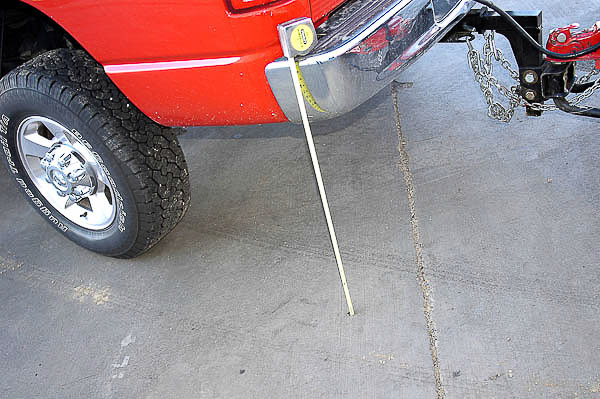
Measure the bumper heights before adding the trailer and load. The torsion bars of the equalizing/load distribution hitch can level the truck’s rear bumper height—regardless of the load on the trailer. Adjustment requires jacking the trailer yoke up to relieve torsion load; adjust the chains, then lower the yoke and measure the bumper height. For stable suspension and handling, I like to place a slight load on the rear springs of the truck, striving for a bumper height roughly 1/4-inch to 1/2-inch lower than when the vehicle is unloaded. An ancillary benefit of an equalizing hitch is that the headlights aim normally with the trailer loaded and attached.
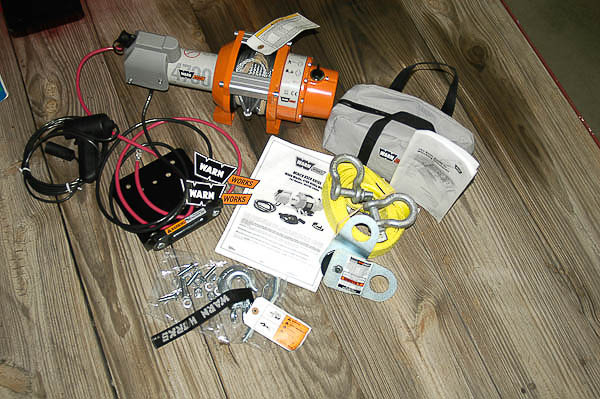
Warn Works Utility Winch at 4,700 pounds line capacity is plenty ample for the rolling resistance of a lighter trail Jeep! Several Warn accessories complement this winch and make pulling safer and easier. This is a versatile approach, with power from an auxiliary battery mounted at the trailer yoke. Remote control places the operator out of harm’s way.
TO SEE THE LATEST DESIGNS IN WARN 3700 AND 4700 SERIES UTILITY WINCHES FOR TRAILER LOADING, CLICK HERE!
FOR THE COMPLETE LINE OF WARN PRODUCTS, CLICK HERE TO VISIT THE WARN WEBSITE!
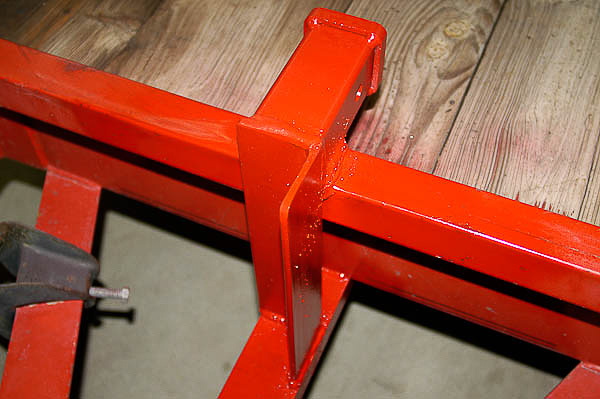
In less than an hour, I fabricated and painted this receiver, tying it to the trailer’s front braces and the center beam of the yoke. A universal 2-inch receiver block and a brace of hefty angle iron make this a sturdy winch anchor point. My MIG welding conforms to the trailer frame’s fabrication, meeting that degree of safety.
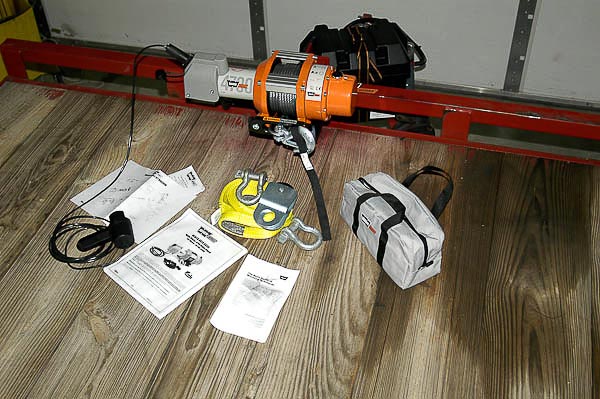
I mounted a marine battery box securely to the yoke, with leads carefully routed into the box. This battery charges from the 7-pin tow vehicle circuit. The Dodge Ram has a factory wiring harness to a common 7-pin plug at the bumper. The trailer has electric brakes at each of the four wheels; an electronic brake controller in the truck’s cab sends a signal to the brakes through the 7-pin connector. Lights are also part of the 7-pin circuit. Always order a truck with factory pre-wiring.

Here are the chains, hooks and vehicle tie-down straps that will secure the vintage Jeep CJ-5 onto the trailer. Note that I use axle straps to protect parts and add security. Chain and strap hooks attach to the short axle straps. Each of these components must be safety rated.

Here, the Warn winch with a remote control switch enables one person to load a Jeep onto the trailer! Gear reduction in the 12VDC/1.9 h.p. winch permits inching the Jeep up the ramp and onto the trailer deck. The winch works in reverse as well, for backing the vehicle off the trailer. If the Jeep is operational, you can drive it onto the trailer. With a winch mounted on the Jeep, you can simulate what I am doing with the Warn utility winch.
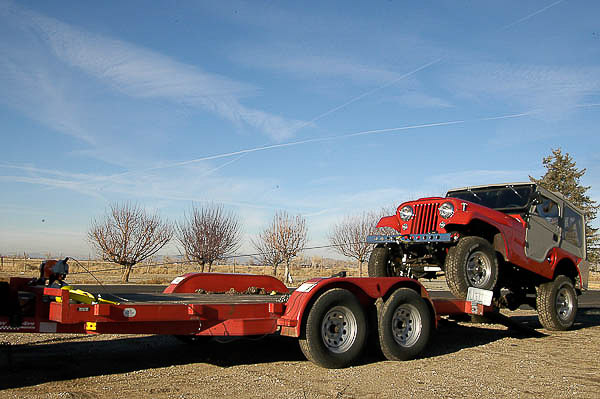
The winch load is greatest when the vehicle climbs the two ramps. This is in part due to the angle of the ramps, and also the angle of the cable. Make sure the trailer is securely latched at the ball hitch!

This is the easy part, hardly any rolling resistance! If possible, I park the tow vehicle and trailer slightly uphill to allow for some resistance on the winch cable. Again, control is excellent with the Warn winch’s reduction ratio. The winch is highly versatile!

The Warn winch tugs the axle strap, which I wrap around the chrome front bumper as protection. These axle straps have a sleeve to prevent chafing against sharp edges. Always avoid edges that will cut an axle strap or rachet strap. This is a controlled, safe way to inch the CJ-5 forward.
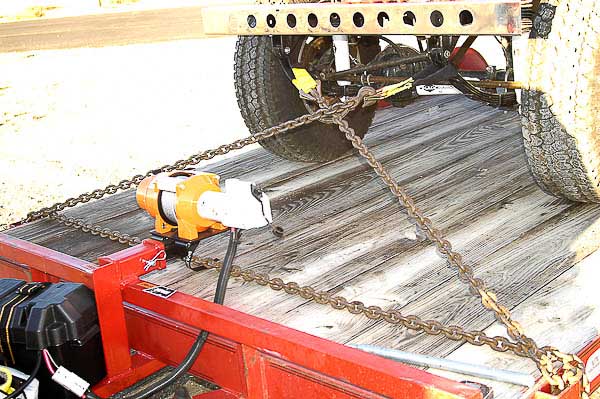
Here, I have plenty of strong chain to form the front cross tie. Note that chains pull from opposite sides to stabilize the load laterally. Axle straps wrap the front of the leaf springs, just behind the anchors. This is a ’55 Jeep CJ with “factory” reversed shackles like the M38A1 military model. Front springs have anchors at the front of each spring; the axle trails from the anchors, an improved method.
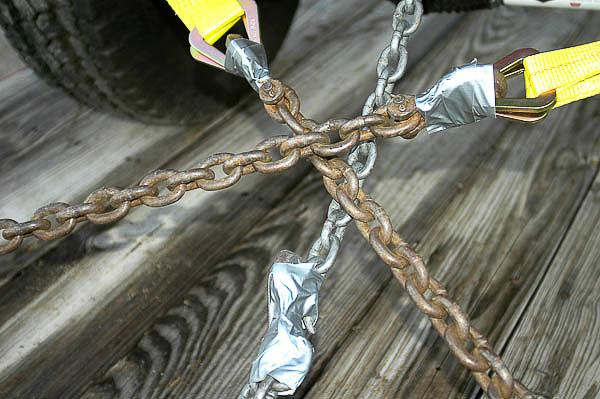
As a safety precaution, I use duct tape to close the open jaw of each chain hook. If the Jeep moves forward and slackens the chain for any reason, these chains will not slip out of the tie straps. Though slacked, the chain would still provide a measure of load control. Mechanic’s wire is an alternative to duct tape.
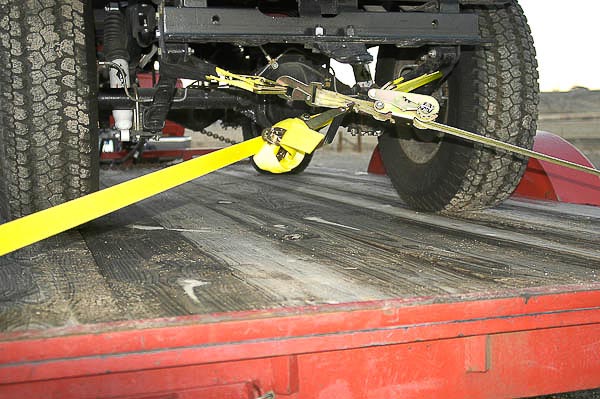
At the rear, I tie the CJ-5 in cross with rachet straps. Again, axle straps provide a cushion against the leaf springs near the shackles. Rachet straps pull rearward and secure the load laterally as well. I could use straps around the axle housing; however, the straps would pull straight rearward and not be able to cross. For this lightweight, shorter Jeep 4×4, I prefer tension plus lateral support at the front and rear.

Rear rachet straps tension the vehicle toward the back end. When tying down, always avoid steering linkage, driveshafts, body parts, brake lines or hoses and light hardware! A Jeep is precious cargo. Secure and tie down with safety in mind. Consider others when trailering.
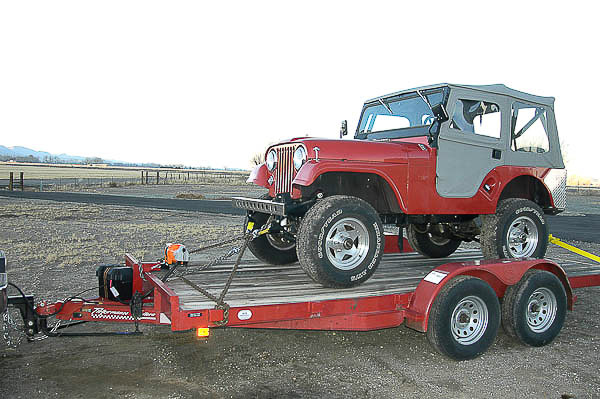
The trailer and load are now secure. Warn Works utility winch can be easily detached with its pin-and-block mount. I remove and stow the winch when not in use. The cables have Anderson-type plugs for handy, quick connecting. A nice package, ready to roll!
TO SEE THE LATEST DESIGNS IN WARN 3700 AND 4700 SERIES UTILITY WINCHES FOR TRAILER LOADING, CLICK HERE!
FOR THE COMPLETE LINE OF WARN PRODUCTS, CLICK HERE TO VISIT THE WARN WEBSITE!

